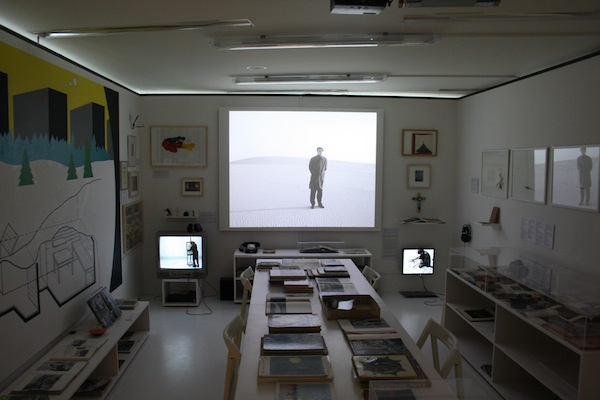
Exposition of Dainius Liškevičius „Museum“ project at National Gallery of Art (19 04 – 20 05 2012 ). NGA image archive
The great Venetian “fair” is here. All countries send their delegates, who are awarded an exceptional occasion of being national heroes and presenting their works to a mob of art tourists and specialists in the historical capital of Western European art and business. This year, as never before, Lithuanian art project is related to Soviet past and its heroes. Dainius Liškevičius interprets history by turning everything into art objects, the entity of art objects turns into a personal narrative, the personal narrative turns into a project that represents the creator, the history of the creator’s homeland, and the creator’s political position.
How important and meaningful are contemporary Lithuanian art and culture, to you and overall? Do you consider yourself to be an institutionalised contemporary artist, representative of organisations that own the means of the political?
To my mind, culture and art are inevitable agents in every Lithuanian citizen’s life, exerting strong influence over it, whether or not one conceives of their existence, for they are mixed in the air that we breathe in and out every second… So, culture and contemporary art are indubitably of immense and vital importance both to myself – your run-of-the-mill “cultural worker” – and to the taxpayer. Affiliation? I have never been or attempted to become an “institutionalised artist”. How do you define an institutionalised creator or an artist that represents institutions? One needs to remember that what we call the beginnings of contemporary art coincide with the establishment of relevant institutions at the beginning of Lithuanian Independence; therefore, if my art has been accepted and demonstrated in these institutions, I do not have to consider myself to be their representative. Freedom is a crucial component of my works and I strive for it harder and harder.
I inquire on institution and freedom, because I would like to hear your opinion on the public debates about painter Aloyzas Stasiulevičius’ and other so-called traditionalists’ resistance to the “destructive influences” of contemporary art. According to you, why is it that hatred towards contemporary art appears and receives a considerable support from the society? Should we react to that, or just write it all off to the category of “homo-sovieticus” and ignore the discourse as unworthy of contemporary artists’ attention?
First of all, I try to observe this construct from above, because otherwise I would have to jostle with my compatriots just to get to the other side, as they do at supermarket sales. I would not say that the show organised by the aforementioned artist and his supporters represent what you call “national values”, because what are they, “work, buy, consume, die”? Touting “national values” is exactly what artists of the nomenclature, demagogues, moralists and homo-sovieticus modernists are best at, because, allegedly, the “real values” existed “back then”, and “now” it is nothing but the Wild West, destruction and public pornography, even in art. It is clear that some people simply do not want to lose their positions and powers. The nation only unites in politically hard times, and it is hard for some people to accept that their social statuses change along with political changes.
Is it not how contemporary art institutionalises itself by using this opposition? The author who believes in freedom and independence is anyway affiliated with one side or the other, and the opposition of conformist/resistant becomes irrelevant, for these are the two currents that dominate in contemporary Lithuanian society: the progressive ones, adhering to liberty, individualism and the free market, and the regressive ones, who base all social aspects on “national values”. What is your opinion on this dominant construct of reality?
Antagonism? I would say, lack of education and common sense. Let us recall a recent case, when Romeo Castellucci’s piece “On the Concept of the Face, Regarding the Son of God” was accused of desecrating national values… I was the target of this exact hysteria, too, after my video performance “Kliaksas”, produced in 2000. According to some under/educated bureaucrats, culture in Lithuania is a waste of money. The conformists long for the times when they were the martyrs, officially recognised by the nation, and they are trying to become resistants again… Too late. I really think that “the girl is innocent”!((Whether “the girl” is guilty or innocent for creating “degenerate art” was a matter of a dispute at a final evaluation at National M. K. Čiurlionis School of Art in Lithuania.))
So you would say that your works are non-conformist both in form and content – but how about local context? I mean, talking about global context of contemporary art, ideas are transmitted and re-transmitted, but they hardly resonate on any larger scale, they turn to tendencies and references, but rarely to origins. Contemporary art became a private ritual for the privileged, hard to enter for an outsider: perhaps that is where the aforementioned antagonism comes from, from non-functional dialogue from both sides, which is not only a problem of traditionalists and their lust for power and privileges, so the antagonism is not exclusively of local nature. For example, let us take the case of Rikrit Tiravanja’s project, when a “free for all” dinner is arranged in the gallery, but only those who have the access to the information limited by the context of contemporary art, can take part: being “socially engaged” becomes a means to legitimate one’s preferred role of an “artist”. Do you justify any means of reflecting one’s freedom of individuality and think that your reflections should reflect social needs, or do you think that by reflecting your freedom you transmit the principle of identification by default?
It is impossible to absorb the whole world. The conflict between individualism and collectivism is eternal, regardless of social field in which it takes place. I do not know how to identify myself, perhaps “Karma Cowboy”. I think that terms like “nonconformism” have shifted and lost stable definitions, now the often-declared “alternative” is only another strategy to position oneself and strive for career, power, conformism… Recently, I watched Belgian director’s Ivo van Hove’s play, based on American philosopher’s and writer’s Ayn Rand’s novel “Fountainhead”, so, just like the main protagonist, I choose the uncompromising creator’s stance. I am incredibly curious about what is going to happen next.
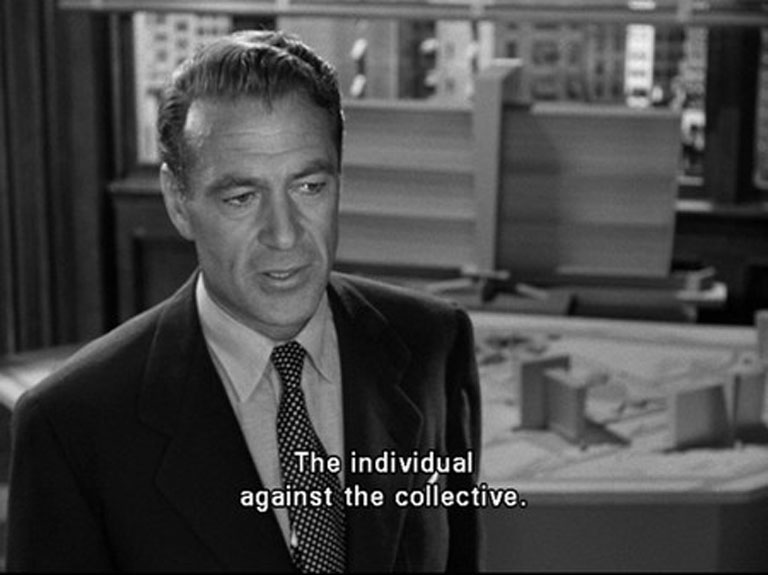
Film still from “Fountainhead”, 1949, dir. King Vidor; after Ayn Rand’s book of the same name
Yes, I have noticed that Ayn Rand’s immensely individualistic character is quite popular, and not only among artists. This phenomenon is quite well analysed in Adam Curtis’ documentary “The Century of the Self”. Sadly, the conflict between collectivism and individualism is determined by Ayn Rand, Margareth Thatcher (not to mention Thomas Hobbes), and other vicious proponents of individualism; it successfully continues after the collapse of the Soviet Union, which is usually presented as a “natural” victory of individualist doctrine against collectivism. What is your opinion on various strategic critiques of the Soviet times and which of them do you support?
If we are talking about a strategic critique of the Soviet times, I choose my individual approach that I have expressed in my “Museum” project. I investigate problems of individualism in a society stifled by authoritarian regime through three personalities – Antanas Kraujelis, Romas Kalanta and Bronius Maigys – that shake the history of Lithuanian SSR not as painters, but as “artists”-protesters against the regime. Not even now, in our free post-soviet society are their actions fully understood and appreciated.
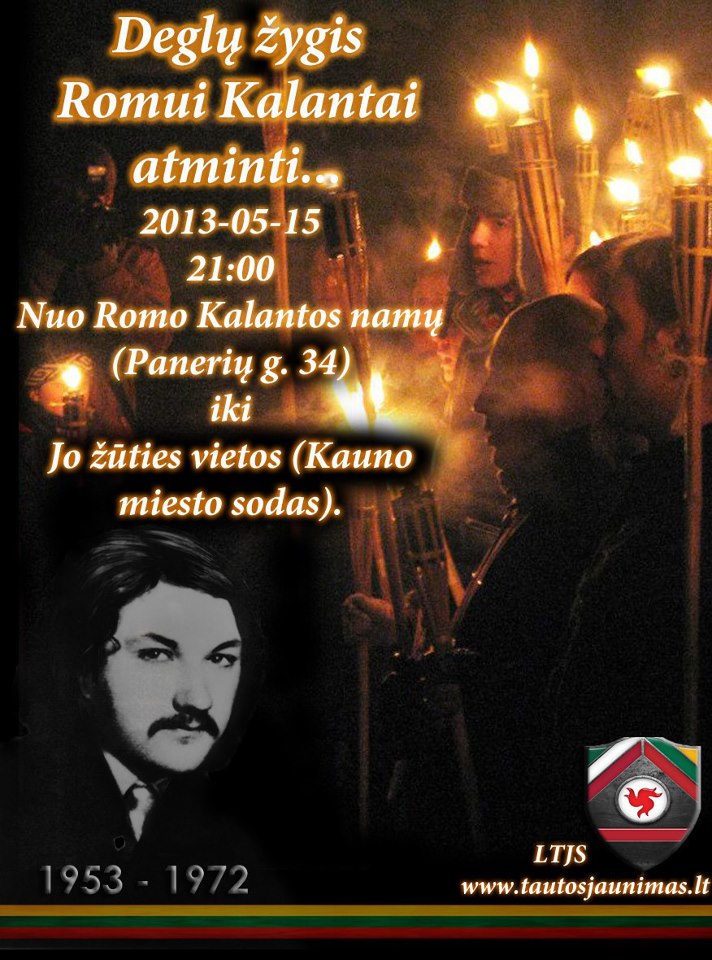
Poster inviting to a torch march in memory of Romas Kalanta
Why do you think they are not appreciated enough? Monuments have been built for Kraujelis and Kalanta, legends are being told about Bronius Maigys.
Firstly, what do you have in mind when you say “not appreciated enough”? Does that mean we can stop talking about them? How about J. P. Sartre at the dunes – what is that about? How can that be appreciated enough? Posthumous order, memorial stone… a line in the history schoolbooks? A monument? Can you specify the legends that are being told about Maigys?
Books are not society. If these “heroes” do not flourish in our cultural space, it means that they are not legitimised conceptually, not “contemporarised”. Regarding Kraujelis, Lithuanian partisans have not yet become what, for example, French partisans are in France. Up to these days, Kraujelis is subject to court processes, adverse articles are written against him etc. And Maigys? A legend? Perhaps in development.
I liked what one historian said on Kalanta: that by overrating certain personalities we forget their context and, by fetishising that or another personality we tend to ignore ambiguous events and problems of the wider scope.
In this particular case I do not think I fetishise them, on the contrary, I expand the context of Lithuanian art through them. Your historian is more actual today, when everything revolves around one personality, that of Vladimir Putin? Am I wrong?
Another question is why call them “artists”, why contextualise them as “art”, although they are thriving in the cultural space with constantly published booklets on partisans, resistance movements, counter(sub)culture of the time and repressions used by the Soviet regime; why is that not enough?
Our past, preserved and represented by state institutions, becomes a formal (“academic”) illustration that continues Soviet traditions and strategies, because the same people from the Soviet past govern them, and their understanding is not always adequate to our contemporary situation, which demands from us many liberties or simply being free.
Long before “Museum”, I started working with Maigys’ “legend condemned to oblivion and misinterpretation”, which nobody knew then, or simply did not want to remember as a very unpleasant fact of art history. I remembered how, in 1985 at my godfather’s place in Kaunas I was listening to “Voice of America” and learned what happened at the Hermitage (it was considered to be an act of political protest then). I think the act performed by Maigys then is still a very important event to Lithuanian culture, a big part of heritage of which is still held at the Hermitage. Later, while working on “Museum”, I related him to other persons who, in my subjective opinion, could stand with him. So, I integrated these “heroes” into my art project, i.e., a simulation of museum as an intervention to the museum of NDG ([Lithuanian] National Gallery of Art), which represents the official attitude to these personalities during the period of [Soviet] occupation. The intervention suggested that they should be integrated into the context of Soviet art as persons who might represent certain art forms, in order to promote a wider perception of art phenomena and processes of the time and their contemporary representations. In my opinion, Lithuanian art, restricted by the system of the time, was only able to emerge into new forms, known in the West, through political protest. That is why I decided to recontextualise it and them from the political to the cultural/art space, where, supposedly, only “internalised resistance” existed “without exceptions”. That is why I call them “artists”.
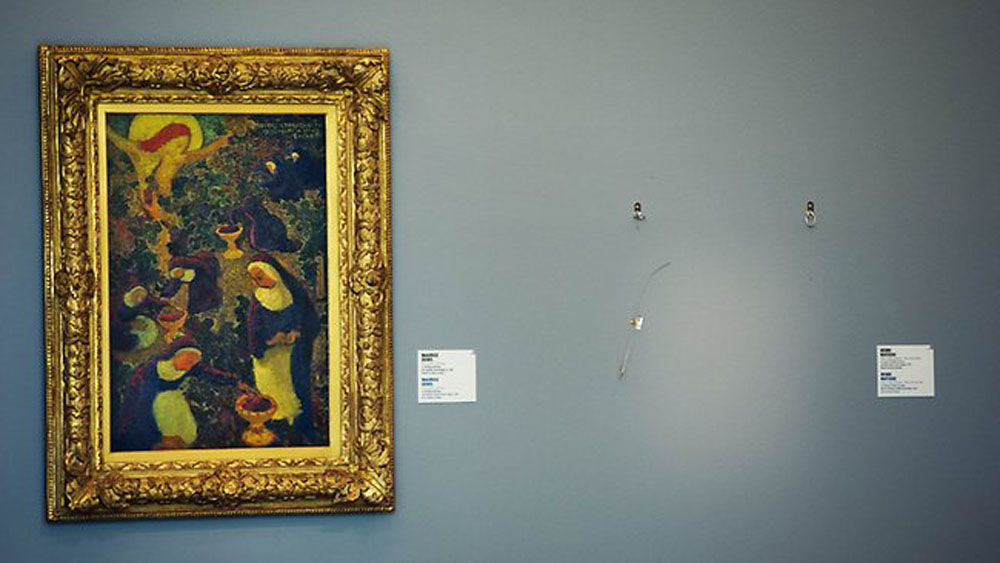
Empty place: Two hooks on the wall marks the place where the stolen Henri Mattise’s “La Liseuse en Blanc et Jaune” painting was hanging before it was taken
Your take on “new forms of art, known in the West” and the need to recontextualise the so-called resistants as artists, is interesting. However, by assuming that these people ought to represent “certain art forms” that obviously come from the West, you choose an extremely modernist methodology. I understand that you see only one way of “contemporarising” these heroes, which is integrating them into what is otherwise called “universal” art history. Do you not think that, for example, Maigys would happily pour sulfuric acid on your book, because to him his action was not related to any form of art and, while maiming a painting in the Hermitage, he thought of it as something more than a protest against the official representation of the occupation (some call it colonisation) period?
I published a text called “BRONIUS MAIGYS / REJECTED TEXT” in my book, in which I analyse the 1985 event in the Hermitage closely, and this event is directly related to culture, therefore its legitimation takes place in the same sphere. While working on the project, I managed meeting Maigys live, in Utena and in Vilnius. Once upon a time I arrived at Utena and called him, but he was at the moment in Vilnius, Taurakalnis market (where antiques are sold and where I got a big part of exhibits to my museum), so I went back to Vilnius. I got an impression that Maigys is a strong introverted personality. I told him about my project and even offered to film him at the Nida dunes, but he refused on the grounds of poor health, which is quite understandable (he is, anyway, more than 70 years old), though he seemed sturdy and able to outlive us all to me. All the questions that I wanted to ask, I asked in the “Museum” project. Answering them is up to the spectator.
I am interested in how you see, for example, the current teachers’ strike, do you see it as a continuation of the protest (resistance) mythology, would you say it is a contemporarisation of the myth of the protest?
Protest is an important component of my project, however, teachers’ (or welders’, or ticket controllers’) strike is organised and coordinated by professional unions, negotiations take place according to the regulations defined by the state, etc. I am first of all interested in a person who chooses a position to express their freedom and who stands out as an individual, whose actions can influence the society and its cultural development. In did not think it important to present all possible forms of protest and events related to them in my project. “Museum” project is a simulation of a museum, its content is a subjective, multilayered presentation of the occupation period through the language of art, and it is left open to discussion and interpretation, so everyone is free to choose their theories and methods of making the incision and how deep the aforementioned incision should be. It is, most probably, hard to understand times that are “untraveled” by one.
We must not forget that the main axis of any work is its CREATOR…
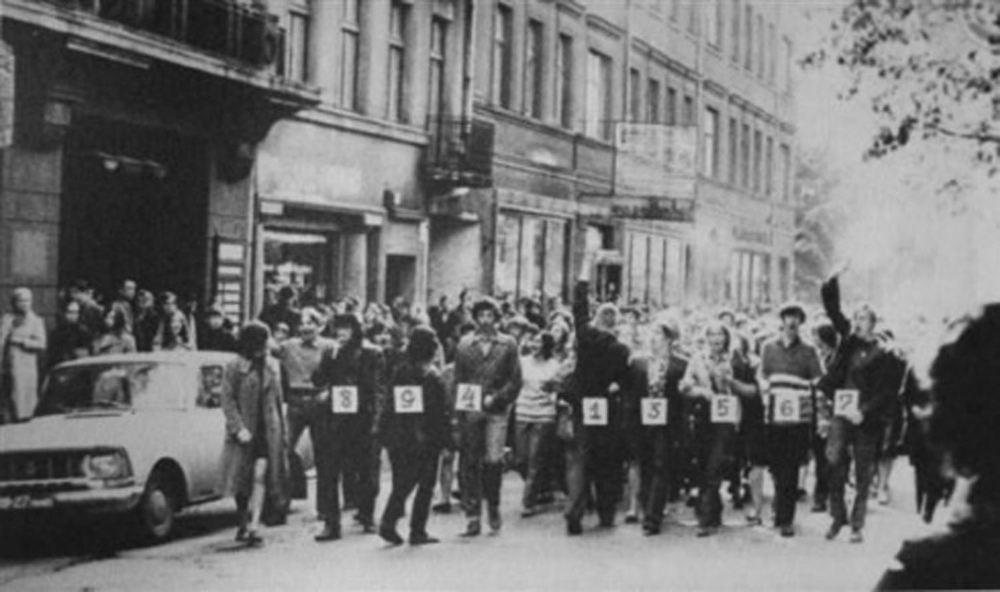
Youth protest rally in Kaunas; KGB archive
Last questions. Recently, I read Redas Diržys’ article in “Kultūros barai” (“Zooexhibitionist visions of conscientious objectors”) and I was caught by the way he criticises the position of an “individual creator”. Quote: “we criticise the artist as a non-specialist, specialised by the capitalist system, who claims to be a producer, but actually accumulates capital generated by the work and/or struggle of others.” What principles do you set for yourself as a creator? By producing art and claiming that the creator is the main axis of any artwork, are you aiming at decentralisation or, on the contrary, at centralisation? What kind of history are you trying to simulate and who should be its owner, having in mind that right now “Museum” belongs to no one else but you, and you are the one that will receive capital – and not only symbolic – for it?
I think that the only way to defend creation is creation itself…
I tried to defeat the past. I do not understand your thesis that “Museum” is “my property now”. As far as I remember, it has always been and will always be my property, one way or another, because authorship is the most important property of a creator. I see the “temptation of a prophet” in your position: to receive “not only symbolic capital”, what is this symbolic capital? An honorary mention, a diploma?.. We can get to the art market this way and disregard all the dominant “idealist” motives of the conversation so far. I think I should start at reminding that I am telling my story, and the form of this story is a simulation of a museum (museum as an institution of memory representation). That way, I can appeal to the “objective truth”, by creating it subjectively, or interpreting it and establishing new entities that can open more than we know or are able to imagine… Art is not only “virtual reality” that helps us avoid ideological truths and structures forced upon us… which mire us to the extent that we start looking for the extraterrestrial art fetish…
Yes, I repeat once more, the main axis of “Museum” project is the creator, the whole story is told through him, from a children’s poem to ideologies that never leave our consiousness, constantly mutating and leading us astray on our paths towards the truth… Of course, if truth is still relevant… I will leave many ellipses to delude the left-handed capitalists and right-footed leftists (…….) and artists and “batmen” who, wherever they live, sit at the government desks all day and fight for “our truth” all night……… Now what I care most about are the bees, for when they die out, we will have to fly to the outter space and look for another Earth, but I am sure art will be necessary there, too. I do not know how we will do it, by centralising or decentralising, but now I am meditating and I am trying to breathe deeply and calmly, it helps one’s sleep by calming down the psychic aparatus, and that is the path to eternity… So now, since our interview is over, I would like to wish everyone good luck and not to worry, the day when the physical world will stop is drawing nigh…
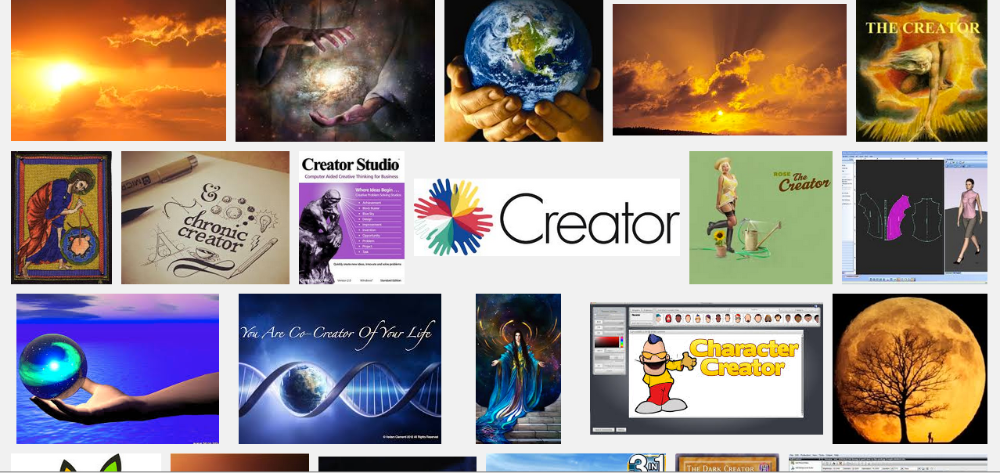
Google image search results for „creator“






























